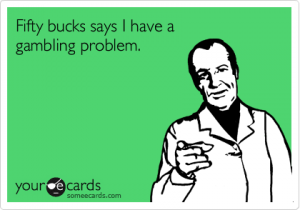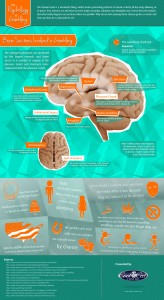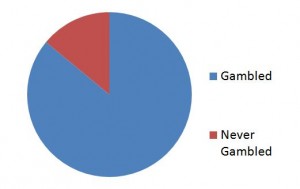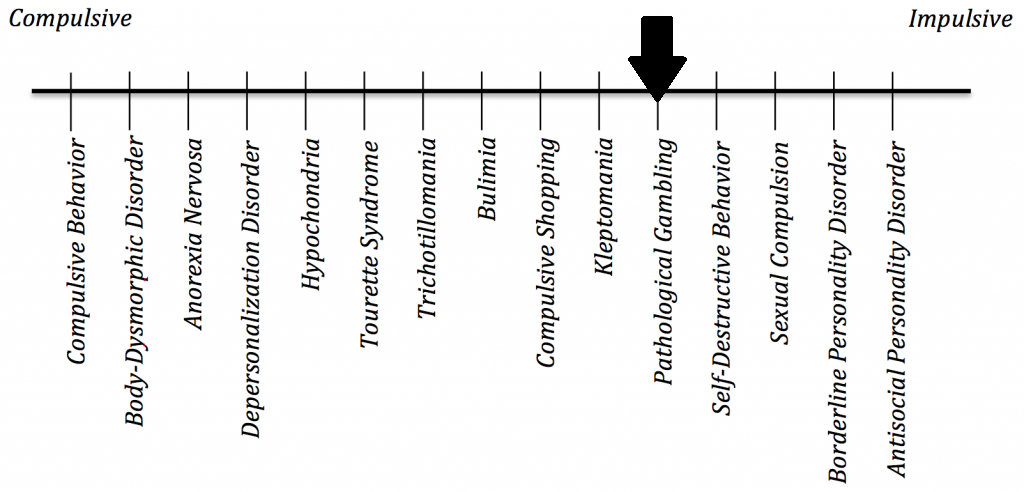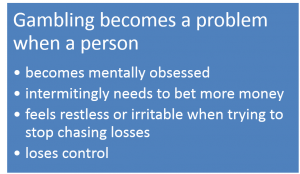Gambling
What is Gambling Addiction?
Gabbling addicts have a non controllable urge to keep gambling despite the toll it takes on their life. Gambling means that they are willing to risk something they value in the hope of getting something of even greater value.
Who doesn’t love winning money? From lining up the 7’s on the slots to watching your horse cross the finish line first, gambling can be an intensely exciting and rewarding game. Everyone knows the odds are stacked against them, but there’s something magical about correctly predicting the future to come out on top. But why does beating the house feel so good? Click the diagram below to see where various aspects of gambling are processed in our brains and make us feel good.
For more information regarding the reward pathway, click here.
As with most things in life, although gambling can make us experience extreme highs, too much of a good thing can become quite the destructive force. Gambling becomes classified as an addiction when one continues to gamble despite the negative impacts it has on their life. This one minute clip of John Oliver’s last week tonight lottery segment shows just how addicting gambling can be (relevant portion ends at 9:33).
– 86% of American claim to have gambled at least once
-5-7% (15-20 million people, or about the population of Australia) are either problem or pathological gamblers
-Americans lost about 91 billion dollars in 2006. To give some perspective, with 91 billion dollars, you could buy Disney and everything they own (list of assets owned by Disney here), and still have over 15 billion dollars left.

Pathological gambling- impulse-control disorder.
Pathological gambling was added to the Diagnostic and Statistical Manual of Mental Disorders (DMS) in 1980 and has been through numerous revisions. Currently, this is the current deffinition of Pathological gambling in the DSM-5:
Persistent and recurrent problematic gambling behavior leading to clinically significant impairment or distress, as indicated by the individual exhibiting four (or more) of the following in a 12-month period:
- Needs to gamble with increasing amounts of money in order to achieve the desired excitement.
- Is restless or irritable when attempting to cut down or stop gambling.
- Has made repeated unsuccessful efforts to control, cut back, or stop gambling.
- Is often preoccupied with gambling (e.g., having persistent thoughts of reliving past gambling experiences, handicapping or planning the next venture, thinking of ways to get money with which to gamble).
- Often gambles when feeling distressed (e.g., helpless, guilty, anxious, depressed).
- After losing money gambling, often returns another day to get even (“chasing” one’s losses).
- Lies to conceal the extent of involvement with gambling.
- Has jeopardized or lost a significant relationship, job, or educational or career opportunity because of gambling.
- Relies on others to provide money to relieve desperate financial situations caused by gambling.
Gambling Behavior–
The addictive qualities of gambling is all about anticipating the reward. Slots, table games, online games, the lottery, as well as almost any other type of gambling game utilize a Variable Ratio Schedule. In this schedule the reward is not given at regular intervals, and is the most powerful type of reward schedule for reinforcing behaviors. Responses are maintained at relatively high rates with few winning outcomes. These payoffs are scheduled based on variable response requirements. People fail to understand the probabilities involved, gambling procedures have very low valued outcomes.
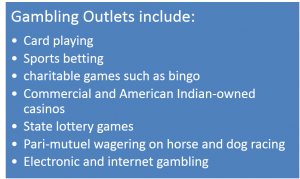
Here is a table of the “house edge” for many different types of games. The house edge is defined as the ratio of the average loss to the initial bet. Gamblers select the less probable outcome over the delayed opportunity to save money. This can be seen in a similar phenomena called the “marshmallow test”.
Case Study of Video of a college student named Ryan.

